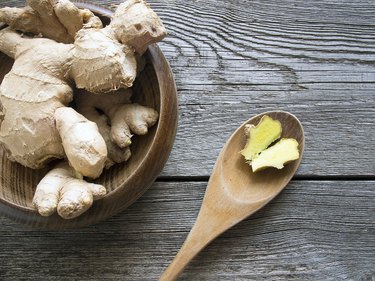
Ginger is a popular spice with many forms and many uses, from pepping up iced tea to adding a fresh note to marinades to creating the familiar aroma and taste of homemade gingerbread. The ginger plant has its origins in Asia, but the spice found in the root has dispersed around the globe. It's essential to regional cuisines throughout the world.
The spice can be eaten fresh, dried and ground to be stored in your spice rack, as liquid extract, minced, pickled or candied. It's also available as a supplement in the form of tablets or capsules.
Video of the Day
Different recipes call for different forms of ginger, so how do you know when you can use a substitute for ginger in a recipe or when a fresh ginger-to-ginger powder conversion can work? It's easy to find both ground and fresh ginger in most supermarkets, but is one better than the other? Can they be used interchangeably?
Video Demonstration from an Expert
Coreen Shakes, of Shakes Bakes, is a professional caterer who performs how to grate ginger.
Ground and Fresh Ginger: What's the Difference?
Fresh ginger, which you'll find in the produce department, is a knobby root with a tough skin and pulpy, rather stringy interior. This pithy core is full of flavor and nutrition, with many people citing gingerol (a natural chemical compound) for its healthy properties such as soothing an upset stomach, easing inflammation and even possibly reducing the risk for cancer. When ginger root is dried and ground, some of that gingerol is lost.
When it comes to flavor, the differences between fresh and ground ginger are readily apparent. Fresh ginger tastes, well, fresh — sharply spicy, with a hint of sweetness and an earthy undertone. The flavor of ground ginger root is more highly concentrated, yet less piquant, and because of its granular nature, is more easily distributed through the dish.
Fresh Ginger vs. Dried Ginger in Recipes
In the wide range of recipes calling for ginger, some demand fresh, some ground, and some can hold up in a fresh ginger-to-ginger powder conversion. Baked items such as gingerbread, gingersnaps, cakes and cookies are much better with ground ginger because of its even distribution; in fact, in these baked goods, you're better off substituting another ground spice such as cinnamon or coriander rather than fresh ginger.
For the complex sauces of Asian, African and other regional cuisines, fresh ginger is almost always best. However, ground ginger can be used in place of fresh if no fresh is on hand. Some cooks recommend a substitution ratio of 1/4-teaspoon ground ginger for every tablespoon of fresh ginger called for, while others call for more. This is a matter of personal taste, so start low, taste your dish as you mix, and if you need to add more, add it a little at a time.
After you peel the ginger, you can either grate it or chop it. Many cooks find the easiest method is chopping the ginger into a small mince with a very sharp knife. The smaller the mince, the better distributed the ginger will be. Grating can be more difficult, since you can wind up with some very stringy stuff.
Another technique would be to use an electric spice grinder. Since fresh ginger pulp can be quite moist, use the wet-blade attachment on the grinder if you have one (look for an electric grinder with wet/dry capabilities to get the most bang for your buck).
It's Best to Have Both on Hand
While it's acceptable to substitute ground ginger for fresh in many dishes — and actually preferable for some baked goods — it's worth it to keep both versions on hand. In fact, both fresh and ground ginger can be stored for long periods of time until they're called for, making it easy to always be prepared.
Fresh ginger root can last for two or three weeks refrigerated or for a couple of months in the freezer. Either way, keep the peel on the unused portion of ginger and close it tightly in a zipper bag. You can then take out as much ginger as you like, cutting off the lengths you need and then leaving the rest in the bag till next time.
Tips
Use the back of a regular spoon to scrape off ginger peel, sweeping away from you; it's faster and easier than using a peeler.